
Timeline...
1880 - 1890

The
World
1882: Thomas Edison builds the first power plant in New York.
1885: Karl Benz patents his first automobile.
1889: The Eiffel Tower opens in Paris.
Canada
In 1885, after long-standing grievances remain unaddressed, Louise Riel
and Gabriel Dumont lead an uprising of Metis in the Saskatchewan River
Valley communities in the Prince Albert - Battleford regions.
Subsequent actions by native groups lead by Big Bear and Poundmaker
create concern in Manitoba communities but relations between settlers
and native people remain peaceful.
Manitoba
1881: March 2 - Manitoba Boundaries Act passed in Parliament, providing
for an extension of the province’s borders.
The town of Brandon is created in May of 1881 when the site is selected
over Grand Valley as a crossing and divisional point on the C.P.R.
Within a month it is a busy centre.
The Assiniboine Rivers floods, putting much of the Assiniboine Valley
under water, much as it was in 2011.
|
|
1883:
An act of the legislature set up 4 municipalities within the
County of Souris River, including Arthur.
Arthur included Ranges 27,28 & 29; townships 1,2, and 3.
Powers given allowed municipalities to bonus industries and railways by
cash donation and by tax exemptions for a number of years.
1884 : In 1884 the Province was divided and organized into separate
Municipalities.
Homestead Regulations eased to attract more settlers. Three options
existed:
1. Three year’s cultivation and residence – with the
settler not absent for more than six months in any one year.
2. Taking up residence for two years and nine months within two miles
of the homestead and then afterwards residing in a habitabgle house on
homestead for three months at any time prior to applying for the
patent. With 10 acres to be broken ion the first year, 15 in the
second, and 15 in the third.
3. A five year system that allowed the settler to live anywhere for the
first two years as long as he began to cultivate the land within six
months and build a habitable house.
1885: The end of steamboat service on the upper Assiniboine.
|

The R.M.
of Argyle
The Argyle Icelanders
A combination of bad luck and bad weather combined with a smallpox
epidemic, harsh winters and wet summers made life extremely difficult
for Icelandic settlers near Gimli, but the colony persevered and
eventually thrived. For those that preferred fishing over farming the
location served them well once they adapted, but it wasn’t great farm
land and that likely prompted some to try their luck elsewhere.
Everett Parsonage, a pioneer of the Pilot Mound district, had worked
for John Taylor in Ontario and through him had contacts with some of
the Icelandic settlers at Gimli. He advised them to visit Argyle. In
August of 1880 Sigurdur Kristofferson and Kristian Jonsson set out to
vist Mr. Parsonage and he showed them a largely unsettled area in the
rolling country in the northern part of the Municipality, an area we
now know as Grund.
As soon as he could Sigurdur, filed on SE 10-6-14 and called his new
home “Grund”, An Icelandic word meaning grassy plain. More soon
followed, with two more men taking homesteads that fall. In the spring
of 1881 four families arrived at their new homes, by winter there were
eight families, then 17 by the next year. By 1884 they had “650
cultivated acres, 60 head of cattle, 62 oxen, 60 sheep, 9 work horses…”
and more. Six schools and a church were built by 1900. Before Baldur
was established a strong community was in place, and although the store
and post office established at Sigurdur Kristofferson home didn’t
evolve into a village, the name Grund has lived on.
1880
In the year 1880 the influx of settlers began in earnest to the east
half of the municipality.
In April John Playfair, his son A.W. and Sam Dowell with George W.
Cramer Sr. with his sons G.W. and A.E. made their way from Emerson,
over the Marringhurst plains into township 5 range 13. Each of those
took home¬steads and pre-emption. In August George W. Playfair the
eldest son of John Playfair, and J. Bernard, ano¬ther son, with their
families number¬ing fifteen in all, came through from Emerson.
In the same year Christopherson Arason, and Johnson hoisted the Union
Jack in the name of the Icelanders north of the Tiger Hills.
Settlement began in the Rosehill district, at first referred to as the
Clark Settlement. Mr. Clark and his family lived together on Sec.
14-4-14
Murdoch McQuarrie, who the first post office in Marringhurst also kept
a stopping place and many old-timers recall the hospitality given them
by Mrs. McQuarrie.
1881
By 1881 the first council of the newly created R.M. of Argyle was in
place although it was not active until 1882.
The first members of Argyle Council: Warden, George W Playfair,
Councillors, F. Butcher, A. Henderson. G. W. Cramer, James Graham, J.
F. Macey, and James McCelland. The new council was sworn in by A. W.
Playfair who was appointed a commissioner by the local legislature of
that date. Mr. Wm. Stark was ap¬pointed clerk and treasurer, a position
he held for several years, and by his uniform kindness and obliging
manner won golden opinions from the ratepayers of Argyle.
Mr. Neelin settled just east of the future town site that was to bear
his name in 1881.
The first woman to tie a sheaf of wheat on this side of the river was
Mrs. Rankin, tied with wire, the first year for crops.
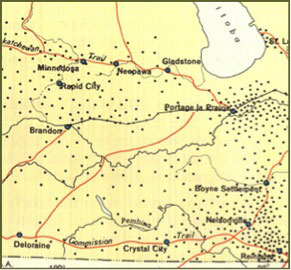
This 1881 map shows that the Argyle region was just beginning to
attract settlement in 1881.
Weir, Thomas R. [Settlement 1870-1921] [map]. 1:3,041,280. In: Thomas
R. Weir. Economic Atlas of Manitoba. Winnipeg: Manitoba Dept. of
Industry and Commerce, 1960, pate 13.
(Warkentin and Ruggles. Historical Atlas of Manitoba. map 153, p. 332
The Glenora Story
Glenora may claim to be the first “town” in Argyle in that there was a
half-hearted effort to promote the original site of Glenora by the
usual method of selling lots to speculators. The site, unlike the many
other wonder towns, did have both some potential and some actual
commercial activity. Thomas Rogers was operating a store on SW
20-3-13.
The first Post Office at Glenora was opened by Thos. Feeley in 1881 on
S ha. 28-3-13. He carried the mail in an oxcart from Pilot Mound, (the
old Mound).
Blaine & Reid built a flour mill north of Rock Lake at the original
site of Glenora. It was the mill that is credited with providing
Glenora with its name. The Ogilvie Milling Co. had a flour mill near
Montreal which they called the Glenora Mill. Their flour bags were
marked "Glenora Patent". When the Flour Mill was built on the SE
¼ 20-3-13, north of Rock Lake, in 1882, the name Glenora was
given to the mill as a compliment to the Ogilvie Co. which owned some
three sections of land close by. The name was then given to the post
office and later to the school. The sawmill was built by Walsh and Sons
of Montreal and Mr. W. J. Porter, later of Baldur, worked in the mill
as manager. George McKnight, early resident of Glenora district, also
worked in the mill and Jim Chester worked in the Flour Mill. Both the
mills were burned down in 1885.
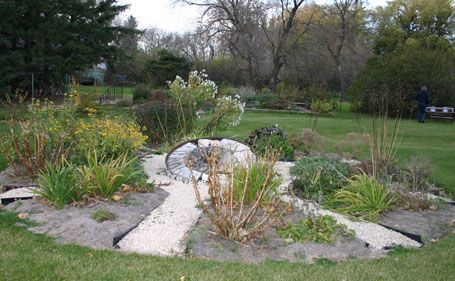 Millstone, on the grounds of the St.
Georges Anglican
Church
Millstone, on the grounds of the St.
Georges Anglican
Church
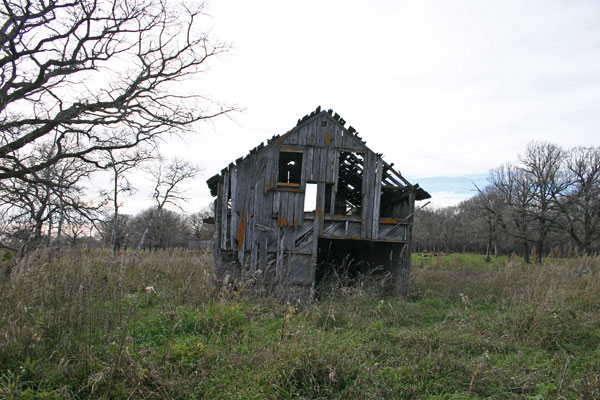
Store from the original Glenora site.
Glenora served the commercial centre of the region for a short
time and is recalled in several pioneer reminiscences. Alex Rankin from
Killarney recalls traveling to Glenora “for grists”. Wlliam
Cummings recalls that the first school in the Huntly area was built of
lumber hauled from Glenora. George Lawrence, later an MLA for
Killarney, operated an agricultural implement business for the Massey
Manufacturing Company at Glenora in 1883, likely out of his homestead.
It appears that the store may have closed soon after the mills burned,
but the name was well enough established to be resurrected when the
railway finally arrived a few kilometers to the northeast. The
millstone from that mill has been carefully placed on grounds of St.
George’s Anglican Church, in that new Glenora.
Wm. Lawrence was born at Uxbridge, Ont., in June 1850 where he spent
his boyhood days. He left home at an early age and spent many laborious
days lumbering. He came west in 1881, landed at Emerson and
walked from there to the Glenora Plains as it was called at that time,
where he took up land and broke it with oxen and went through the same
hardships as other early pioneers.
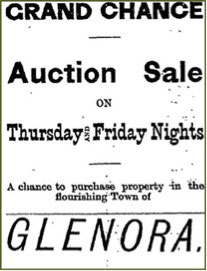 Winnipeg Daily Sun - Sept. 13, 1881
Winnipeg Daily Sun - Sept. 13, 1881
Otenaw
Before the coming of the Northern Pacific and Manitoba Railway to the
district in 1889, the settlement from Dry River to Grund was named
Otenaw. The post-office was on sec¬tion 16-5-13, and was kept by A. W.
Playfair, who drew the mail from Pilot Mound. The greater number of the
early settlers came from the province of Ontario and reached the
district in 1881
A less successful attempt was made to create the town of Glasgow on Twp
5 Range 13 (somewhere between Greenway and Baldur). Lots were offered
for sale in the Rock Lake Herald, Sept, 1, 1881. But there is no record
of any development occurring.
1882
“Mr. J. Chester, proprietor of the Chester House, Baldur, in connection
with which he runs a livery stable, ten good drivers being constant¬ly
on the road; and also deals in flour, bran, shorts and oatmeal with
which his warerooms are kept well stocked, came to this country in 1882
from Lanark county, Ontario, and was the pioneer settler in 5-14,
engaging in farming half a mile west of the present town. Mr. Chester
was instrumental in selec¬ting the present site of Baldur, after the
advent of the railroad in 1889.” Gazette 1899
The First Schools
In 1882 Mr. Porter negotiated with Wm. Clark for the construction of a
school. He took a petition around to be signed, the school was built,
and called Rosehill after Mr. Porter's farm. It was built on the
North-east corner of section 16-4-14 which was the centre of the
township.
The Wigton School was built in 1882, cut and erected by the settlers,
the carpenters were Mr. William Macorquadale, Sheffield, Bell and
Huffman. The first trustees were McLellan, M. Rankin, Scott, Glouston.
The secreta¬ry treasurer was Wm. Reid.
The Marringhurst School district was organized in the winter of 1881-82
with Bentley D. William Galloway and John Wilson as trustees, with
James Butchard as first teacher in the district. D. W. Minden and J.J.
Elsey were among the first pupils. The present school was erected in
1892.
1883
Mr. Porter also was the instigator for the formation of post-office
service for the Rosehill district. The post office was called Moropano
in preference to Rosehill because there happened to be another post
office somewhere by that name.
The first school built in the Baldur district was the Tiger Hills
school on the McDonald homestead in 1883. A building bee took place
with a committee of four, Messrs. McAulcy, Chester, Hodgkinson and
Norton. The teacher was Mrs. J. Chester, who had to write to Ontario
for a permit to teach in Manitoba, as she had been a teacher in that
province before her marriage.
1884
Jon Olafson called the meeting. "All farmers" are present and 36
persons of over 18 years join in forming a congregation which they call
Frikirkju congregation, indicating by the name, their non attachment to
any state church. This was New Year's Day 1884. Trustees elected were:
Bjorn Jansson. Skapti Arason, Skull Arnason.
The original Hecla School was built on 16-6-14.
The first picnic in the district took place in 1884 at Jones's Lake.
Baldwin Benedickson entertained at stilts. Sigurjon Snydal shone in the
ox race.
Rosehill School built.
Local news…
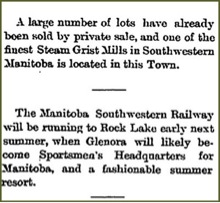 Winnipeg Daily Sun - Dec 3,
1884
Winnipeg Daily Sun - Dec 3,
1884
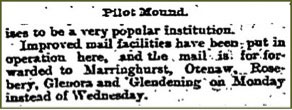
Winnipeg Daily Sun - Dec 3, 1884
1885
John Montague, an early settler on Sec 30-3-12, brought in the first
steam thresher in 1885.
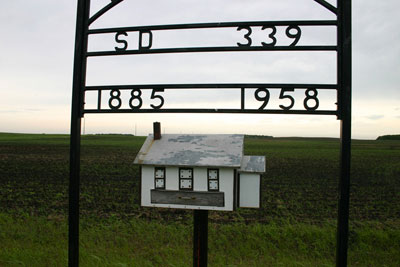
Dry River SD. # 339, 1885 – 1958, NW 22-4-12
Cypress Valley SD. # 394, was established in 1885 – 1958. The first
school was on N 24-6-13.
1886
By 1886 15 school districts had been established.
Roseberry School was built on SW 33-3-14 in 1886 by contract. R.B.
Watson was responsible for the building. The trustees were Wm. Stark,
John Neelin and H.N. Cooper The latter being the Sec.-Treas.,
too. The first teacher was John Lawrence and then Mrs. B. C. Martin,
John Gochen, G. Peters A. McGinnis, A. E. Buttress, A. S. Rose, D. A.
Ross, Miss Kitty Lockerby, Miss B. Leece and Miss Carrie Cumming. One
teacher was dismissed because he taught by sound… the parents fearing
his sanity.
South of the old Roseberry School in 1886 on SW 28-3-14 Mr. John Neelin
had a Grocery Store and part time had the Post Office, the mail being
driven from Pilot Mound. Before that Alex Kelso had the mail in
Moropano, 5 miles west of Roseberry.
1887
Bru SD. # 368 established. The first building was on SE 16-6-13
1888
Marringhurst Anglican Church is built on Sec. 24-3-13. Mr. George
Stewart of Dry River was the builder. Mr. Joseph Stevens (father of the
late editor of the Baldur Gazette) plasters the interior in the
following year. Rev. A. D. Wood is one of the first ministers to preach
in the new building.
1889
Frelsis (Grund) Church built.
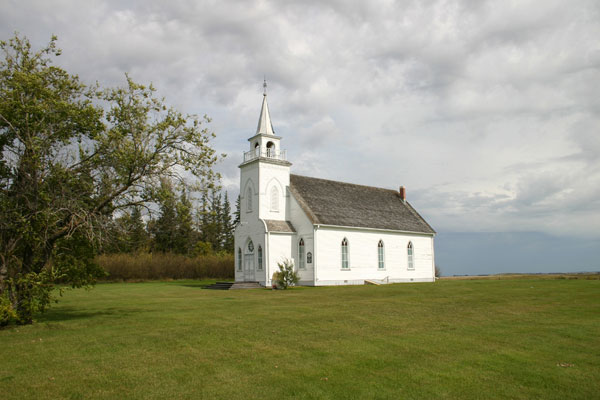
Frelsis Church in 2010
The Northern Pacific is being run from Morris to Brandon.
In the fall of 1989 Mr. G.W. Playfair moves his grain buying business
(which he conducts for Bawlf & Co.) to the new town site in a
building he also moved from its previous location on his farm. Once the
issue of the town site is firmly settled he moves the building to the
front street and begins a lumber, furniture and coal business.
Jesse Chester’s house becomes a sort of unofficial restaurant for
railway workers and he is soon persuaded to open a boarding house that
becomes known as the Chester House.
St. George’s Anglican Church built at Marringhurst.
Baldur is Born
In 1889, after several unsuccessful efforts to secure a much-needed
rail link, the Canadian Northern Pacific Railroad (a branch of the
American company), proposed a line linking Morris with Brandon and
passing through the center of Argyle. The towns of Greenway and Belmont
were quickly established. But that left quite a stretch without a
station and farmers felt they deserved better service.
Settlers in the district directly west of the present town and the
north and south were not sat¬isfied. To their way of thinking, a
station should be placed between, Greenway and Belmont.
While the surveyors were busy grading the line, farmers in the Otenaw
district lead by A.W Playfair, suceeded in convincing the railway
company that another station was needed. The first site chosen was
three miles west of the present town and again citizens including Jesse
Chester, Reeve Peter Strang and Sigurdur Chistopherson, rallied in
support of the current location. The surveyor reconsidered and chose a
location a few miles further east. This still wasn’t what the locals
had in mind and Jesse Chester apparently carried the surveyor’s
equipment himself to the current site. His persuasion won out and in
the spring of 1890 land was purchased from M.T. Cramer and Mr. Taggart
for $7.00 per acre.
Given that beginning, the name “Chesterville” suggested by a railway
official Mr. Lehorn would have seemed appropriate, but Sigurdur
Chistopherson’s daughter Carrie has been given credit for the
suggesting name “Baldur” the Nordic God of innocence and summer sun. A
vote settled the issue and Baldur it was. Carrie herself was recognized
in the name of the second avenue of the new town.
Previous to this Mr. G.W. Cramer had undertaken grain buying for the
Bawlf Grain Company. He had built a spur at the track, and brought a
building from his farm for his winter grain buying on sleigh. Mr. A.E.
Cramer moved an old creamery, often referred to as the Cheese factory,
of which Mr. Brown was the cheese maker, to the present site of Mr.
Kilgour’s store and sold it to G.W. Griffiths for a General Store in
the spring of 1890, although the townsite was not yet settled.
The Bethel church, a frame building was moved in from the Welsh farm
out from the prairies south west of town to site of the present United
Church. Later the present church was built and the frame building moved
and finally dismembered and the parts used for various purposes
throughout the town. The Tiger Hills School was moved into town by W.
Playfair and used for the municipal Hall. G. W. Cramer built a
blacksmith shop, manned by Harry Goodman, who had deserted his trade to
go on a homestead five miles east of town. This blacksmith shop was
placed where Stillwell's is now.
The development of the new town was well under way.
|

|





